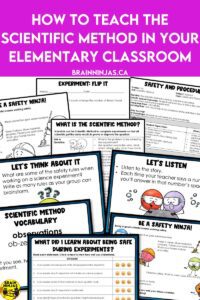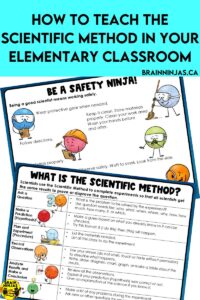
The scientific method has been around for thousands of years and if you went to school, you learned about it, too. The method helps keep experiments and investigations fair so they can be repeated and results can be verified. All scientists use this method which helps verify results.
When you are teaching science, it is important that students understand the method-even if they cannot remember all the names of the steps. It more important that students get to work hands-on and focus on curiosity than following and writing out a set of steps.
Come learn how we teach students about the scientific method in our science class.
What Is the Scientific Method?

Before teaching the scientific method, it’s important that scientists understand the steps. Explore how scientists ask questions, make predictions, test ideas, and draw conclusions. The steps can be simplified for students as:
- Ask a question (Question) – What do I want to find out?
- Make a prediction (Hypothesis) – What do I think will happen?
- Plan and test (Materials and Procedure) – How can I find out?
- Observe and record (Observations) – What do I notice or measure?
- Analyze and Communicate (Conclusion) – What do the results tell me? How can I share what I learned?
- Reflect (Ask New Questions) – What new questions do you have?
Keep these steps simple and visual. This helps students see science as a process rather than a checklist.
How to Introduce The Scientific Method
Start with a real-world question that connects to the science unit you are teaching. For example:
- Which type of soil holds the most water?
- Do different types of plants need different amounts of water?
- How does changing the angle of a ramp affect how far a toy car rolls?
- Which surface causes the most friction?
- What happens to shadows when the light source moves closer or farther away?
- Does the slope of inclined plane change the amount of effort needed to push it up?

If you don’t have a specific lesson but want to practice going through the process, you can use this simple experiment. It can be part of a simple machines unit or just a quick experiment to practice the scientific method. Find the free lesson in our TpT Store or our BN Shop.
Once students have a question, walk through each step together. Model how to make predictions, design fair tests, and record observations clearly.
Make The Experiment Hands-On
Kids learn science best when they do science. Here are some simple ideas that can apply to nearly every science unit:
- Experiment stations: Let small groups test different variables (e.g., different materials, amounts of light, or temperatures).
- Science journals: Have students draw diagrams, label equipment, and describe what they see in their own words. Teach students that diagrams should be labeled and neat (even if the drawings aren’t perfect).
- Anchor charts: Build a class chart of the scientific method and add real examples as you go through units.
- Use our lessons: We have lots of different hands-on experments in our science lessons. Find all our science in our TpT Store ($USD) or BN Shop ($CAN). If you teach in Alberta, we have lists of all our aligned resources to help you find what you need quickly.
You can even connect this process to other subjects — writing hypotheses in English, graphing data in math, or exploring traditional Indigenous knowledge that also values observation and respect for nature.
If you need a set of blank experiment pages that are templated for the scientific method, we can send these to you for free when you sign up for our email list. If you are already a ninja, find the pages in the Resource Library.
Connect to Indigenous Ways of Knowing

Encourage students to recognize that First Nations, Métis, and Inuit Peoples have long practiced observation, testing, and learning from the environment. For example, you can highlight:
- Careful observation of animal behaviour to understand seasonal changes.
- Knowledge passed through stories that explain cause and effect in nature.
- Respectful use of natural materials — taking only what is needed and cleaning up so there are materials available for others to use.
These connections help students see that inquiry and observation are not just “modern science” ideas but part of traditional knowledge systems, too.
Keep It Student-Centered
Encourage students to create their own questions. Even if the experiments are small, the sense of ownership makes a big difference. When students test their ideas, they see themselves as scientists.
Try posting a question wall where students add questions about what they notice in class or outdoors. You can turn these into future investigations using the scientific method.
Get This Free Scientific Method Activity for Your Classroom
We created a simple lesson to teach our students how to be safe while completing experiments. It’s a great reference page or you can use it as an anchor chart in your classroom. It’s combined in a resource about the scientific method. We’ll send the lesson to you for free when you sign up for our email list. If you’re already on the list, you can find the activity in the Resource Library.

Looking for More Science Activities?
The scientific method is about curiosity, not perfection. By guiding students through questioning, testing, and reflecting, you’re helping them build the habits of real scientists.
When we teach inquiry in a way that’s hands-on, connected to culture, and driven by wonder, we’re not just teaching science — we’re teaching students how to think, explore, and care about the world around them.
We have lots of blog posts on specific science topics.
- How to Teach Human Body Systems to Young Scientists
- Dig Up Dinosaurs in Alberta With These Amazing Activities
- How to Teach Students About the Earth’s Spheres
- Create These 5 Fantastic Devices That Move
- How to Escalate Your Chemistry Experiments
- Astronomy Lessons That Are Out of This World
How do you like to teach students about the scientific method? Let us know in the comments below.









Leave a Reply